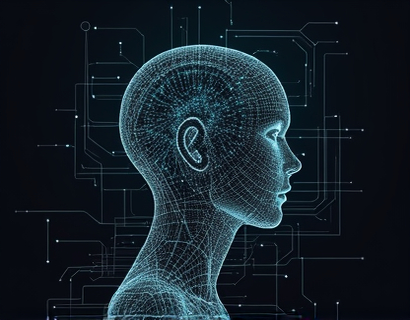Unlocking Digital Transformation: Leveraging AI and Crypto for Enhanced User Engagement in the Tech Ecosystem
The digital landscape is undergoing a profound transformation, driven by the convergence of artificial intelligence (AI) and cryptocurrency technologies. This synergy is not just a trend but a fundamental shift that promises to redefine how users interact with digital platforms and services. By harnessing the power of AI and crypto, businesses and innovators can unlock new levels of user engagement, drive growth, and stay ahead in an increasingly competitive tech ecosystem.
To fully understand the potential of this technological fusion, it's essential to explore the individual capabilities of AI and cryptocurrency, and then examine how they can be combined to create transformative experiences. This article will delve into the key aspects of AI and crypto, their applications in enhancing user engagement, and provide actionable strategies for leaders and innovators to leverage these technologies effectively.
Understanding AI and Its Role in Digital Transformation
Artificial intelligence, a subset of computer science, focuses on creating systems that can perform tasks requiring human intelligence, such as learning, reasoning, and problem-solving. AI technologies include machine learning, natural language processing, computer vision, and predictive analytics. These tools enable machines to process vast amounts of data, identify patterns, and make informed decisions, significantly enhancing the efficiency and personalization of digital services.
In the context of digital transformation, AI plays a pivotal role by automating routine tasks, providing insights through data analysis, and creating personalized user experiences. For instance, AI-driven chatbots can offer 24/7 customer support, reducing response times and improving customer satisfaction. Predictive analytics can help businesses anticipate user needs and preferences, allowing for proactive engagement strategies. Additionally, AI-powered recommendation systems can enhance user experience by suggesting relevant content or products based on individual behavior and preferences.
Exploring the World of Cryptocurrency and Blockchain
Cryptocurrency, a digital or virtual currency secured by cryptography, has revolutionized the way we think about money and transactions. Beyond being a medium of exchange, cryptocurrency and blockchain technology offer a decentralized, transparent, and secure framework for various applications. Blockchain, the underlying technology, is a distributed ledger that records transactions across multiple computers, ensuring data integrity and immutability.
In the tech ecosystem, blockchain can enhance trust and security in user interactions. Smart contracts, self-executing contracts with the terms directly written into code, can automate and enforce agreements without intermediaries, reducing costs and increasing efficiency. Tokenization, the process of converting assets into tokens on a blockchain, can create new revenue models and increase liquidity for users and businesses alike.
Synergy of AI and Crypto: Enhancing User Engagement
The true power of AI and crypto emerges when they are combined to create innovative solutions that enhance user engagement. This synergy can lead to more secure, personalized, and rewarding digital experiences. Here are some key areas where AI and crypto can work together to transform user interaction:
- Decentralized Identity Management: AI can enhance the user experience by creating secure and seamless identity verification processes. By integrating blockchain, user identities can be stored and managed decentralized, giving users control over their personal data while ensuring security and privacy.
- Tokenized Rewards and Incentives: AI can analyze user behavior to design personalized reward systems, while cryptocurrency tokens can serve as a medium for distributing these rewards. This combination can motivate users to engage more deeply with digital platforms, fostering loyalty and active participation.
- Enhanced Data Privacy and Security: AI can help detect and prevent fraudulent activities by analyzing patterns and anomalies in user data. Blockchain's immutable ledger ensures that once data is recorded, it cannot be altered, providing an additional layer of security. Together, these technologies can build trust and confidence among users.
- Personalized Content and Recommendations: AI algorithms can process vast amounts of user data to deliver highly personalized content and recommendations. On a blockchain-based platform, these recommendations can be verified and rewarded, creating a closed-loop system where users are incentivized for their engagement and contributions.
- Decentralized Marketplaces: AI can optimize the matching of buyers and sellers in decentralized marketplaces, ensuring efficient and fair transactions. Cryptocurrency facilitates seamless and borderless transactions, reducing friction and expanding the user base.
By leveraging the strengths of both AI and crypto, businesses can create a more engaging, secure, and rewarding digital environment. This not only enhances user satisfaction but also drives retention and growth.
Strategies for Implementing AI and Crypto in Digital Transformation
For leaders and innovators looking to harness the power of AI and crypto, here are some actionable strategies to consider:
First, conduct a thorough assessment of your current digital ecosystem. Identify areas where AI and crypto can add the most value, such as improving user authentication, personalizing user experiences, or creating new revenue streams. This assessment should involve stakeholders from various departments to ensure a comprehensive understanding of the potential impact.
Second, invest in talent and expertise. The intersection of AI and crypto is a rapidly evolving field, and staying ahead requires continuous learning and adaptation. Hire or collaborate with experts who have a deep understanding of both technologies. This could include data scientists, blockchain developers, and UX designers skilled in creating AI-driven interfaces.
Third, start with pilot projects. Implementing AI and crypto on a large scale can be complex and resource-intensive. Begin with small-scale pilot projects to test and refine your approaches. For example, you could launch a tokenized loyalty program or an AI-powered chatbot to gauge user response and gather feedback.
Fourth, focus on user education and communication. Explaining the benefits and workings of AI and crypto to users can be challenging but crucial. Develop clear and accessible content that demystifies these technologies and highlights how they enhance the user experience. Transparency and education will build trust and encourage adoption.
Fifth, ensure compliance and ethical considerations. As with any technology involving data and financial transactions, compliance with regulations is essential. Stay informed about local and international laws governing AI and cryptocurrency. Additionally, prioritize ethical practices, such as data privacy and fair use of AI algorithms, to maintain user trust and avoid potential backlash.
Lastly, monitor and iterate. The tech landscape is dynamic, and what works today may need adjustment tomorrow. Continuously monitor the performance of your AI and crypto initiatives, gather user feedback, and be prepared to make iterative improvements. This agile approach will help you stay relevant and responsive to user needs.
Case Studies and Real-World Applications
To better understand the practical applications of AI and crypto in enhancing user engagement, let's look at a few real-world examples:
One notable example is the use of blockchain and AI in the gaming industry. Companies like Axie Infinity have created a decentralized gaming platform where players can own in-game assets as NFTs (non-fungible tokens). AI is used to balance gameplay, generate dynamic content, and personalize user experiences. This combination has led to a highly engaged community and new revenue streams for players.
In the finance sector, DeFi (Decentralized Finance) platforms leverage AI and blockchain to offer innovative financial services. For instance, Compound and Aave use AI to optimize lending and borrowing processes, while ensuring transparency and security through blockchain. These platforms provide users with better control over their assets and more favorable terms compared to traditional financial institutions.
Another example is the use of AI-driven personalized marketing on blockchain-based platforms. Companies like SingularDB use AI to create unique digital identities for users, ensuring that marketing efforts are both targeted and respectful of user privacy. By tokenizing user data, these platforms create a secure and incentivized ecosystem where users are rewarded for their engagement and data sharing.
These case studies demonstrate the potential of AI and crypto to transform various industries and enhance user engagement in meaningful ways.
Conclusion
The convergence of AI and cryptocurrency represents a significant leap forward in digital transformation, offering unprecedented opportunities to enhance user engagement and drive growth. By understanding the individual strengths of these technologies and exploring their synergistic potential, businesses and innovators can create more secure, personalized, and rewarding digital experiences.
As the tech ecosystem continues to evolve, those who embrace and effectively leverage AI and crypto will be well-positioned to lead the charge. By following the strategies outlined in this article and learning from real-world applications, leaders can unlock the full potential of this technological fusion and stay ahead in the digital age.










































